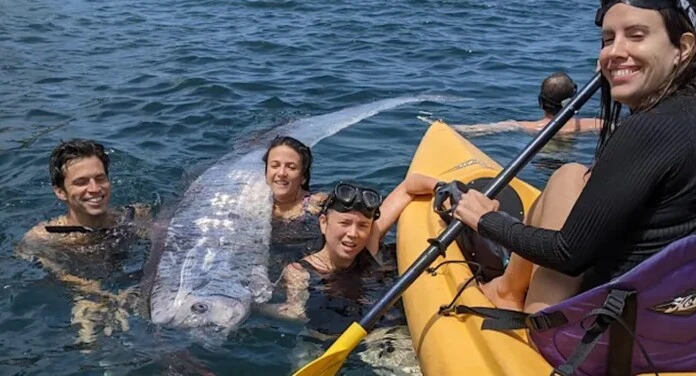A group of intrepid kayakers and snorkelers had their curiosity piqued when they spotted a massive shape floating in the water ahead of them. Driven by a blend of excitement and intrigue, they paddled closer to capture footage of a rare and awe-inspiring marine creature.
While enjoying a recreational paddle near La Jolla Cove, California, they encountered an oarfish (Regalecus glesne)—a creature steeped in legend and known as an omen of upheaval. This elusive species typically inhabits the deep waters of the open ocean, far from the reaches of most human activity.
According to a Facebook post by the Scripps Institution of Oceanography, only 20 oarfish have been recorded washing up in California since 1901. Fortuitously, this particular oarfish was discovered by marine science professionals who recognized the significance of their find.
The Smithsonian Institute notes that the five seafarers quickly alerted the National Oceanic and Atmospheric Administration’s (NOAA) Fisheries Service and California Sea Grant—a collaboration involving federal, state, and university resources. They also enlisted the help of passing paddleboarders and lifeguards to assist in transporting the 12-foot-long giant to the kayak landing.
The oarfish holds the Guinness World Record for the longest bony fish. A specimen recorded off Asbury Park, New Jersey, in 1963 by scientists from the Sandy Hook Marine Laboratory was estimated at an astonishing 50 feet (15.2 meters) long. The longest photographed oarfish measured 27 feet, more than double the size of the one recently found in La Jolla Cove.
Known for its remarkable length and deep-sea habitat, the oarfish is often linked to sea serpent myths. It inhabits all oceans except the polar regions and occasionally surfaces, leading many to speculate that it inspired ancient sea serpent legends.
In Japanese mythology, the oarfish is known as “ryugu no tsukai,” or “Messenger from the Sea God’s Palace,” linked to the sea deity Ryūjin. It is believed that the appearance of an oarfish foretells earthquakes. Notably, the oarfish was sighted before the 2011 Tohoku earthquake that triggered the Fukushima Nuclear Disaster.
The La Jolla oarfish surfaced just two days prior to a 4.4-magnitude earthquake that shook Los Angeles.
NOAA’s Southwest Fisheries Science Center and Scripps Oceanography will conduct a necropsy to determine the cause of death. Following the examination, the specimen will be preserved in the Scripps Marine Vertebrate Collection, one of the world’s largest repositories of deep-sea fish, for further study.
